Museum of Applied Arts, Vienna
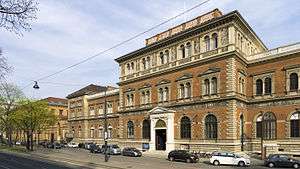 Museum of Applied Arts in Vienna, Austria | |
| Former name | k. k. Österreichisches Museum für Kunst und Industrie |
|---|---|
| Established | 1864 |
| Location | Stubenring 5, Vienna |
| Type | Design Museum |
| Director | Christoph Thun-Hohenstein |
| Architect | Heinrich von Ferstel |
| Public transit access |
|
| Website |
www |
The MAK – Austrian Museum of Applied Arts / Contemporary Art is an arts and crafts museum located at Stubenring 5 in Vienna’s 1st district Innere Stadt. Besides its traditional orientation towards arts and crafts and design, the museum especially focuses on architecture and contemporary art.[1]
History
On 7 March 1863, the Imperial Royal Museum of Art and Industry - today's MAK—was founded by Emperor Franz Joseph I. Rudolf von Eitelberger, the first Professor of art history at the University of Vienna, was appointed director. Following the example of London’s South Kensington Museum (today’s Victoria and Albert Museum) which was founded in 1852, the museum aims at serving as an exemplary collection for artists, industrialists, and the public and as an institution for education and training of designers and craftspeople. The museum opened on 12 May 1864, at first provisionally in rooms of the Ballhaus building next to the Vienna Hofburg, which were adapted for the purpose of the museum by architect Heinrich von Ferstel.
With the establishment of the k.k. Wiener Kunstgewerbeschule (Vienna School of Arts and Crafts) in 1967, theoretical and practical training was united. At first, the school was housed in the former gun factory at Währinger Straße 11–13/Schwarzspanierstraße 17 (nowadays the Anatomical Institute of the Medical University of Vienna which was newly constructed in 1886). Only after the construction of an extension next to the Imperial Royal Austrian Museum of Art and Industry, did the school move to Stubenring 3 where it opened in 1877.
1897, Arthur von Scala, until then director of the Royal Middle Eastern Museum (later Royal Austrian Trade Museum), takes over as director of the Museum of Art and Industry, bringing Otto Wagner, Felician von Myrbach, Koloman Moser, Josef Hoffmann and Alfred Roller on board to work at the museum and at the School of Arts and Crafts. Due to conflicts between Scala and the Arts and Crafts Association (founded in 1884), who sees his influence on the museum beginning to wane, Archduke Rainer resigns 1898 as the museum’s protector. New statutes were drawn up. Two years later, around 1900, the museum and the School of Arts and Crafts each received their own separate administration, although their final separation did not take place until 1909: The museum was placed under the aegis of the Ministry of Culture and Education, the school stayed at the Royal Ministry of Cultus and Education. In 1907, the Museum of Art and Industry took over most of the collection of the Royal Austrian Trade Museum.
_p1178_%C3%96sterreichisches_Museum_f%C3%BCr_Kunst_und_Industrie.jpg)
From 1865 to 1897, the Museum of Art and Industry also published the magazine Mittheilungen des k. k. Österreichischen Museums für Kunst und Industrie (Transactions of the Imperial Royal Austrian Museum of Art and Industry). From 1898 to 1921, however, the Museum Journal was published with the new name Kunst und Kunsthandwerk and soon gained international reputation. The museum began publishing the periodical alte und moderne kunst (old and modern art).
After the establishment of the First Republic, the holdings previously in the possession of the Habsburgs—e.g. oriental carpets—were handed over to the Museum. In 1936 and 1940, the Museum on Stubenring gave part of its sculpture collection to the Kunsthistorisches Museum [Museum of Art History]. In exchange, it received the arts and crafts section of the collections of Albert Figdor and of the Kunsthistorisches Museum. Following Austria’s annexation by Nazi Germany, the museum was renamed “Staatliches Kunstgewerbemuseum in Wien” (State Arts and Crafts Museum in Vienna). Between 1939 and 1945, Austria’s museums take over several confiscated private collections. The collection of the “State Arts and Crafts Museum” also expanded in this way. Since 1998, numerous works of art have been restituted to their owners as a result of provenance research.
In 1947, the “Staatliches Kunstgewerbemuseum in Wien” (State Arts and Crafts Museum) was renamed “Österreichisches Museum für angewandte Kunst” (Austrian Museum of Applied Arts). In 1949, the museum reopened following the repair of war-related damage. In 1965, the Geymüllerschlössel in Vienna’s 18th district was affiliated to the museum and became a new branch. At the same time as the building, the MAK also acquired Dr. Franz Sobek’s important clock collection (160 Old-Viennese clocks from the time between 1750 and the second half of the 19th century) as well as furniture from the years 1800 to 1840. In the late 1980s, parts of the wall paintings were returned to their original state in the course of the renovation of the façade. The subsequent rearrangement of the furniture and the extraordinary clock collection in the rooms of the Geymüllerschlössel have provided visitors with an authentic insight into the diversity of Biedermeier interior decorating until today.[2]
The Arenbergpark Flak Tower—one of the six flak towers erected in Vienna during World War II—became an additional branch of the museum in 1994 and since 1995 has served as the MAK Contemporary Art Depot (MAK Tower), which hosts major parts of the Contemporary Art Collection of the museum. Currently, the MAK Tower is closed to the public due to a lack of official approval.[3]
After a MAK exhibition about Josef Hoffmann in 1992 in his house of birth in Brtnice/Pirnitz (Czech Republic), contact with the Moravian Gallery in Brno(Czech Republic) has been intensified. Finally, since 2006 both institutions have managed Hoffmann’s birthplace as a joint branch—the Josef Hoffmann Museum. The museum presents its collection in a permanent exhibition and, at the same time, temporary exhibitions about Josef Hoffmann and his contemporaries.[4]
In 1994, the MAK founded the branch MAK Center for Art and Architecture in Los Angeles, USA. The center is now located in three important buildings of the Viennese architect Rudolph M. Schindler in Los Angeles (Rudolph Schindler House, Pearl M. Mackey Apartment House, Fitzpatrick-Leland House). The focus is on new trends and interdisciplinary developments in the fields of fine arts and architecture which are expedited through scholarships and projects and are expanded through temporary exhibitions.[5]
One important sphere of influence of the MAK is its presentation in public space. The museum actively supports contemporary artists, whose works are mostly presented in an exhibition in the MAK building and later as works of art in Vienna's urban space in order to mediate at the interface between art and public space. International artists such as James Turrell (MAKlite, Permanent installation on the façade of the MAK since 2004, Stubenring 5, 1010 Vienna[6]), Michael Kienzer (Stylit, 2005, Stubenring/Weiskirchnerstraße, 1010 Vienna[7]), Franz West (4 Larvae (Lemur Heads) 2001, Stubenbrücke, 1010 Vienna[8]), Donald Judd (Stage Set, 1996, Stadtpark, 1030 Vienna[9]) and Philip Johnson (Wiener Trio, 1998, Franz-Josefs-Kai/Schottenring, opposite Ringturm, 1010 Vienna[10]) have been represented.
In 2000, Austria’s federal museums were removed from state administration; the museum became a “public-law academic institution.”
In 2015, the MAK initiated the Vienna Biennale, the first Biennale to combine art, design and architecture. It lasted from 11 June to 4 October 2015 and was initiated by the MAK in partnership with the University of Applied Arts Vienna, Kunsthalle Wien, the Architekturzentrum Wien, and the Vienna Business Agency, creative center departure, and organized with support from the AIT Austrian Institute of Technology as a non-university research partner. The second Vienna Biennale took place from 21 June to 1 October 2017.
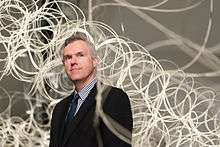
Directors
- Rudolf Eitelberger (1863–1885)
- Jacob von Falke (1885–1895)
- Bruno Bucher (1895–1897)
- Arthur von Scala (1897–1909)
- Eduard Leisching (1909–1925)
- Hermann Trenkwald (1925–1927)k
- August Schestag (1927–1932)
- Richard Ernst (1932–1950)
- Ignaz Schlosser (1950–1958)
- Viktor Griessmaier (1958–1968)
- Wilhelm Mrazek (1968–1978)
- Gerhard Egger (1978–1981)
- Herbert Fux (1981–1984)
- Ludwig Neustifter (Interim. director, 1984–1986)
- Peter Noever (1986–2011)
- Martina Kandeler-Fritsch (Interim. director, Februar to August 2011)
- Christoph Thun-Hohenstein (since September 2011)
In 2016, Christoph Thun-Hohenstein was appointed Director or rather General Director and Artistic Director of the MAK for another 5 years. At the same time, Teresa Mitterlehner-Marchesani—in the course of the introduction of joint management of the Austrian Federal Museums—was appointed Managing Director.
Building
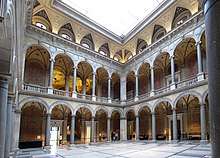
From 1869, a new museum complex for the Imperial Royal Museum of Art and Industry was built at Stubenring 5 in the style of the Neo-Renaissance, according to plans by Heinrich von Ferstel. The painter Ferdinand Laufberger made a frieze in sgraffito and the fresco paintings on the mirror vault of the staircase. On 15 November 1871, the museum opened to the public within a big opening. It was the first museum building on the Vienna Ring Road. Laufberger's cartoons were lost, and so around 1893 the mural painting of the figures on the outer façade were recreated by students of Karl Karger of the School of Applied Arts. In 1875 the Austrian Museum was joined by an adjacent new building for the School of Applied Arts at Stubenring 3, whose plans were also drawn up by Heinrich von Ferstel. It was opened in 1877.
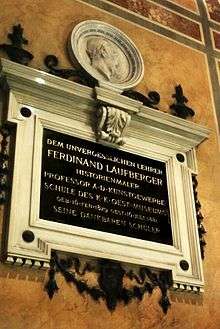
In 1906, Ludwig Baumann designed an extension building for the museum located at Weiskirchnerstraße 3, it was completed in 1908. After World War II repair of war-related damage to the museum building lasted until 1949.
In 1989, a complete renovation of the museum’s old buildings and construction of both a two-story underground depot and a connecting wing by with a generous storage facility and additional exhibition space began. After this renovation, the museum opened in 1993. Its showrooms were designed by artists such as Barbara Bloom, Eichinger or Knechtl, Günther Förg, Gangart, Franz Graf, Jenny Holzer, Donald Judd, Peter Noever, Manfred Wakolbinger and Heimo Zobernig. In 2014, a repositioning of the Permanent Collection Carpets with an artistic intervention by Füsun Onur and a repositioning of the Permanent Collection Asia, whose artistic design was entrusted to Tadashi Kawamata in 2014 and 2016, took place.
The building in the Weiskirchnerstraße is reserved for temporary exhibitions, while the rooms at Stubenring host the permanent collections and the MAK DESIGN LAB.
MAK Permanent Collection
In accordance with its historical justification, the MAK Permanent collection is divided into different sections according to its functional purpose.[11]
- Vienna 1900 Design / Arts and Crafts 1890–1938
- Carpets
- Asia. China – Japan – Korea
- Renaissance Baroque Rococo
- Baroque, Rococo, Classicism
- Empire Style Biedermeier
- Historicism Art Nouveau
Highlights of the collection are the holdings of the Wiener Werkstätte, chairs by Thonet and Kohn, furniture by Danhauser, Gustav Klimt's cartoons for the Mosaic Frieze of Stoclet Palace, Du Paquier’s Porcelain Cabinet chamber from Dubsky Palace, a collection of Bohemian and Venetian glass, Flemish and Italian lace, silver, porcelain and carpets as well as Chinese porcelain, Japanese colored woodcuts (Ukiyo-e) and Japanese printing stencils (Katagami).
MAK Design Lab
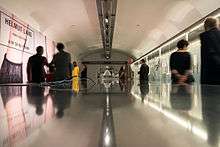
On the occasion of its 150th anniversary, the MAK positioned itself more clearly than ever before as a museum for arts and the everyday world. Until 2014, the MAK Study Collection presented part of its extensive holdings in a material-specific technological order. In the course of this repositioning of the former study collection, MAK cooperated with the Austrian design team EOOS and the IDRV - Institute of Design Research Vienna in order to make cross-links between 21st century art and earlier epochs directly tangible.[12]
Since its transformation into the MAK Design Lab, almost 2,000 exhibits - divided into themed islands - have created a newly conceived showcase in the entire basement of the museum for lifelike references between historical arts and crafts and contemporary design. Interactive thematic areas form an illustrative course on areas such as cooking (including a replica of Margarete Schütte-Lihotzky's Frankfurt kitchen), eating and drinking, sitting, artistic, industrial and alternative production, transporting, communicating and ornament, and the Helmut Lang Archive, which shows the artistic highlights with selected designs.[13]
The newly created passageways and modular units lead to a connecting spatial experience and allow rapid adaptation to changing requirements. The MAK Forum forms a flexibly usable space, which is used as a meeting place as well as an experimental area for exhibitions and mediation formats.
In the MAK Works on Paper Room temporary exhibitions take place—mostly from the holdings of the Library and the Works on Paper Collection—with a richness of topics presenting posters, architecture projects, style imitations, and Japanese woodblock prints, for example.
The MAK Library and Works on Paper Collection conveys information about all areas of applied art. The literature encompasses the time from the 16th century up to the present with some manuscripts, incunabulas, and printed works ranging from the 15th century until today. The Works on Paper Collection comprises ornamental engravings, posters, photos, hand drawings, watercolors, and plans as well as hand drawings from the archives of the Wiener Werkstätte.
The MAK Contemporary Art Collection serves as a presentation room for contemporary projects by international artists, i. a. engaging with topics from the fin de siècle period.
With its MAK Collection Online the MAK makes parts of its collection accessible to the public:
- Japanese colored woodcuts / Ukiyo-e
- East Asian Art
- Late antiquity textiles
- Posters
- Ornamental prints
- Wiener Werkstätte - Drawings
- Joseph Binder—Graphic Design
- English fabrics and wallpapers around 1900 (Arts and Crafts Movement)
Since May 2017, the MAK with its collection highlights can also be visited virtually on Google Arts & Culture:[14][15] Gigapixel images of Gustav Klimt’s design drawings for the execution of a frieze in the dining room of the Stoclet Palace in Brussels (1910-1911) can be seen as well as parts of the heroic epic Hamzanama, which is one of the major works of painting in the Islamic world.
Awards
- 1996: "Museum of the Year Award" from the Council of Europe, Strasbourg
Exhibitions
|
|
MAK Branches
The MAK Branches[148] cover several continents and countries:
- Vienna: MAK Branch Geymüllerschlössel MAK Tower Contemporary Art Depot at the Arenbergpark (currently closed) MAK Art in Public Space
- Czech Republic: Josef Hoffmann-Museum, Brtnice/Pirnitz (since the beginning of 2006, a joint branch of the Moravian Gallery in Brno and MAK Vienna)
- USA: MAK Center for Art and Architecture, Los Angeles (Rudolph Schindler House, Pearl M. Mackey Apartment House, Fitzpatrick-Leland House).
Nearby buildings
References
- ↑ "MAK Vienna - MAK Museum Vienna". mak.at. Retrieved 2018-04-12.
- ↑ "MAK Branch Geymüllerschlössel - MAK Museum Vienna". mak.at. Retrieved 2018-04-12.
- ↑ "MAK Tower - MAK Museum Vienna". mak.at. Retrieved 2018-04-12.
- ↑ "Josef Hoffmann Museum - MAK Museum Vienna". mak.at. Retrieved 2018-04-12.
- ↑ "MAK Center for Art and Architecture, Los Angeles - MAK Museum Vienna". mak.at. Retrieved 2018-04-12.
- ↑ "James Turrell – MAKlite - MAK Museum Vienna". www.mak.at. Retrieved 2018-04-12.
- ↑ "Michael Kienzer – Stylit - MAK Museum Vienna". www.mak.at. Retrieved 2018-04-12.
- ↑ "Franz West – 4 Larvae (Lemur Heads) - MAK Museum Vienna". www.mak.at. Retrieved 2018-04-12.
- ↑ "Donald Judd – Stage Set - MAK Museum Vienna". www.mak.at. Retrieved 2018-04-12.
- ↑ "Philip Johnson – Wiener Trio - MAK Museum Vienna". www.mak.at. Retrieved 2018-04-12.
- ↑ "The MAK Permanent CollectionPermanent Collection Vienna 1900Permanent Collection Renaissance Baroque RococoPermanent Collection Historicism Art NouveauPermanent Collection Empire Style BiedermeierPermanent Collection Baroque Rococo ClassicismPermanent Collection ASIAPermanent Collection CarpetsWorks on Paper RoomWiener WerkstättePermanent Collection Contemporary ArtPermanent Collection Art Nouveau Art DecoPermanent Collection 20th/21st Century ArchitecturePermanent Collection Asia Permanent Collection Romanesque Gothic RenaissancePermanent Collection OrientTextiles Study CollectionThe Frankfurt KitchenStudy Collection Seating FurnitureMetal Study CollectionCeramics Study CollectionGlass Study Collection - MAK Museum Vienna". mak.at. Retrieved 2018-04-12.
- ↑ "MAK DESIGN LAB". mak.at. Retrieved 2018-04-12.
- ↑ "HELMUT LANG ARCHIVE". mak.at. Retrieved 2018-04-12.
- ↑ "MAK on Google Arts & Culture - MAK Museum Vienna". www.mak.at. Retrieved 2018-04-12.
- ↑ "MAK – Austrian Museum of Applied Arts / Contemporary Art - Google Arts & Culture". Google Cultural Institute. Retrieved 2018-04-12.
- ↑ "FIRING CELLS - MAK Museum Vienna". www.mak.at. Retrieved 2018-04-16.
- ↑ "OTTO NEURATH - MAK Museum Vienna". www.mak.at. Retrieved 2018-04-16.
- ↑ "JOSEF DABERNIG - MAK Museum Vienna". www.mak.at. Retrieved 2018-04-16.
- ↑ "ARTISTS IN FOCUS #8 HANS WEIGAND - MAK Museum Vienna". www.mak.at. Retrieved 2018-04-16.
- ↑ "FAT / Sam Jacob - MAK Museum Vienna". www.mak.at. Retrieved 2018-04-16.
- ↑ "MING - MAK Museum Vienna". www.mak.at. Retrieved 2018-04-16.
- ↑ "INA SEIDL - MAK Museum Vienna". www.mak.at. Retrieved 2018-04-16.
- ↑ "FLOWERS FOR KIM IL SUNG - MAK Museum Vienna". www.mak.at. Retrieved 2018-04-16.
- ↑ "MINIMAL - MAK Museum Vienna". www.mak.at. Retrieved 2018-04-16.
- ↑ "APOKALYPSE / KEINEN KEKS HEUTE - MAK Museum Vienna". www.mak.at. Retrieved 2018-04-16.
- ↑ "PROJECT VIENNA - MAK Museum Vienna". www.mak.at. Retrieved 2018-04-16.
- ↑ "JOSEF DABERNIG - MAK Museum Vienna". www.mak.at. Retrieved 2018-04-16.
- ↑ "ARTISTS IN FOCUS #9 Plamen Dejanoff - MAK Museum Vienna". www.mak.at. Retrieved 2018-04-16.
- ↑ "DESIGN CRIMINALS. Or a New Joy into the World - MAK Museum Vienna". www.mak.at. Retrieved 2018-04-16.
- ↑ "MIHÁLY BIRÓ - MAK Museum Vienna". www.mak.at. Retrieved 2018-04-16.
- ↑ "DAVID ZINK YI - MAK Museum Vienna". www.mak.at. Retrieved 2018-04-16.
- ↑ "CROSSOVER - MAK Museum Vienna". www.mak.at. Retrieved 2018-04-16.
- ↑ "LEATHER, FABRIC AND ZIPPER - MAK Museum Vienna". www.mak.at. Retrieved 2018-04-16.
- ↑ "CONTEMPORARY - MAK Museum Vienna". www.mak.at. Retrieved 2018-04-16.
- ↑ "100 BEST POSTERS 09 - MAK Museum Vienna". www.mak.at. Retrieved 2018-04-16.
- ↑ "ANDREA BRANZI - MAK Museum Vienna". www.mak.at. Retrieved 2018-04-16.
- ↑ "EVA SCHLEGEL - MAK Museum Vienna". www.mak.at. Retrieved 2018-04-16.
- ↑ "BRUNO - MAK Museum Vienna". www.mak.at. Retrieved 2018-04-16.
- ↑ "THE GREAT VIENNESE CAFÉ: A LABORATORY - MAK Museum Vienna". www.mak.at. Retrieved 2018-04-16.
- ↑ "APPLY! - MAK Museum Vienna". www.mak.at. Retrieved 2018-04-16.
- ↑ "ARTISTS IN FOCUS #10 ERWIN WURM - MAK Museum Vienna". www.mak.at. Retrieved 2018-04-16.
- ↑ "SPAN (Matias del Campo & Sandra Manninger) - MAK Museum Vienna". www.mak.at. Retrieved 2018-04-16.
- ↑ "KURT RYSLAVY, COLLECTOR, WINE MERCHANT, SUNDAY PAINTER. - MAK Museum Vienna". www.mak.at. Retrieved 2018-04-16.
- ↑ "THE EMPEROR'S NEW COLORS - MAK Museum Vienna". www.mak.at. Retrieved 2018-04-16.
- ↑ "THE SECOND SKIN - MAK Museum Vienna". www.mak.at. Retrieved 2018-04-16.
- ↑ "INDUSTRIAL FURNITURE - MAK Museum Vienna". www.mak.at. Retrieved 2018-04-16.
- ↑ "RUDOLF STEINER - Alchemy of the Everyday - MAK Museum Vienna". www.mak.at. Retrieved 2018-04-16.
- ↑ "ARTISTS IN FOCUS #11 WALTER PICHLER - MAK Museum Vienna". www.mak.at. Retrieved 2018-04-16.
- ↑ "MICHAEL WALLRAFF - MAK Museum Vienna". www.mak.at. Retrieved 2018-04-16.
- ↑ "THE GREAT VIENNESE CAFÉ: A LABORATORY - MAK Museum Vienna". www.mak.at. Retrieved 2018-04-16.
- ↑ "ARTISTS' BOOKS ON TOUR - MAK Museum Vienna". www.mak.at. Retrieved 2018-04-16.
- ↑ "GÔM SÚ’ - MAK Museum Vienna". www.mak.at. Retrieved 2018-04-16.
- ↑ "2 x 100 Best Posters at the MAK - MAK Museum Vienna". www.mak.at. Retrieved 2018-04-16.
- ↑ "ENVISIONING BUILDINGS - MAK Museum Vienna". www.mak.at. Retrieved 2018-04-16.
- ↑ "PATRICK RAMPELOTTO - MAK Museum Vienna". www.mak.at. Retrieved 2018-04-16.
- ↑ "THE MAGIC OF DIVERSITY - MAK Museum Vienna". www.mak.at. Retrieved 2018-04-16.
- ↑ "GUSTAV KLIMT: Expectation and Fulfillment - MAK Museum Vienna". www.mak.at. Retrieved 2018-04-16.
- ↑ "sound:frame festival 2012 - MAK Museum Vienna". www.mak.at. Retrieved 2018-04-16.
- ↑ "... FURNITURE OF ALL KINDS: - MAK Museum Vienna". www.mak.at. Retrieved 2018-04-16.
- ↑ "STIEFEL & COMPANY ARCHITECTS - MAK Museum Vienna". www.mak.at. Retrieved 2018-04-16.
- ↑ "MADE 4 YOU - MAK Museum Vienna". www.mak.at. Retrieved 2018-04-16.
- ↑ "THINGS. - MAK Museum Vienna". www.mak.at. Retrieved 2018-04-16.
- ↑ "KURT SPUREY. SEDIMENTS - MAK Museum Vienna". www.mak.at. Retrieved 2018-04-16.
- ↑ "Benjamin Hirte - MAK Museum Vienna". www.mak.at. Retrieved 2018-04-16.
- ↑ "TALIAySEBASTIAN - MAK Museum Vienna". www.mak.at. Retrieved 2018-04-16.
- ↑ "Masterpieces - MAK Museum Vienna". www.mak.at. Retrieved 2018-04-16.
- ↑ "Contemporary Necklaces - MAK Museum Vienna". www.mak.at. Retrieved 2018-04-16.
- ↑ "Others - MAK Museum Vienna". www.mak.at. Retrieved 2018-04-16.
- ↑ "Vienna 1900 - MAK Museum Vienna". www.mak.at. Retrieved 2018-04-16.
- ↑ "100 Best Posters 11 - MAK Museum Vienna". www.mak.at. Retrieved 2018-04-16.
- ↑ "WerkStadt Vienna - MAK Museum Vienna". www.mak.at. Retrieved 2018-04-16.
- ↑ "KATHI HOFER - MAK Museum Vienna". www.mak.at. Retrieved 2018-04-16.
- ↑ "Nippon Chinbotsu - MAK Museum Vienna". www.mak.at. Retrieved 2018-04-16.
- ↑ "Signs Taken in Wonder - MAK Museum Vienna". www.mak.at. Retrieved 2018-04-16.
- ↑ "Marco Dessí - MAK Museum Vienna". www.mak.at. Retrieved 2018-04-16.
- ↑ "A Shot of Rhythm and Color - MAK Museum Vienna". www.mak.at. Retrieved 2018-04-16.
- ↑ "J E X - Jewelry Exhibition - MAK Museum Vienna". www.mak.at. Retrieved 2018-04-16.
- ↑ "LOOS - MAK Museum Vienna". www.mak.at. Retrieved 2018-04-16.
- ↑ "Kerstin von Gabain - MAK Museum Vienna". www.mak.at. Retrieved 2018-04-16.
- ↑ "Verena Dengler - MAK Museum Vienna". www.mak.at. Retrieved 2018-04-16.
- ↑ "LISA TRUTTMANN - MAK Museum Vienna". www.mak.at. Retrieved 2018-04-16.
- ↑ "SONIC FABRIC - MAK Museum Vienna". www.mak.at. Retrieved 2018-04-16.
- ↑ "100 Best Posters 12 - MAK Museum Vienna". www.mak.at. Retrieved 2018-04-16.
- ↑ "Pae White - MAK Museum Vienna". www.mak.at. Retrieved 2018-04-16.
- ↑ "SCIENTIFIC SKIN feat. Bare Conductive - MAK Museum Vienna". www.mak.at. Retrieved 2018-04-16.
- ↑ "FRANZ VON ZÜLOW - MAK Museum Vienna". www.mak.at. Retrieved 2018-04-16.
- ↑ "sound:frame 2014 - MAK Museum Vienna". www.mak.at. Retrieved 2018-04-16.
- ↑ "soma architecture - MAK Museum Vienna". www.mak.at. Retrieved 2018-04-16.
- ↑ "AFTER-IMAGES: - MAK Museum Vienna". www.mak.at. Retrieved 2018-04-16.
- ↑ "EXEMPLARY - MAK Museum Vienna". www.mak.at. Retrieved 2018-04-16.
- ↑ "HOLLEIN - MAK Museum Vienna". www.mak.at. Retrieved 2018-04-16.
- ↑ "HANNA KRÜGER. [Die Sammlung] - MAK Museum Vienna". www.mak.at. Retrieved 2018-04-16.
- ↑ "South meets North: Local Innovation. Global Conversation - MAK Museum Vienna". www.mak.at. Retrieved 2018-04-16.
- ↑ "TOMORROW IS... - MAK Museum Vienna". www.mak.at. Retrieved 2018-04-16.
- ↑ "Valentin Ruhry - MAK Museum Vienna". www.mak.at. Retrieved 2018-04-16.
- ↑ "100 Best Posters 13 - MAK Museum Vienna". www.mak.at. Retrieved 2018-04-16.
- ↑ "Schwadron Brothers: - MAK Museum Vienna". www.mak.at. Retrieved 2018-04-16.
- ↑ "I SANTILLANA - MAK Museum Vienna". www.mak.at. Retrieved 2018-04-16.
- ↑ "photo::vienna - MAK Museum Vienna". www.mak.at. Retrieved 2018-04-16.
- ↑ "Ways to Modernism - MAK Museum Vienna". www.mak.at. Retrieved 2018-04-16.
- ↑ "JEWELLERY 1970–2015 - MAK Museum Vienna". www.mak.at. Retrieved 2018-04-16.
- ↑ "EOOS - MAK Museum Vienna". www.mak.at. Retrieved 2018-04-16.
- ↑ "Alfredo Barsuglia - MAK Museum Vienna". www.mak.at. Retrieved 2018-04-16.
- ↑ "AMIE SIEGEL - MAK Museum Vienna". www.mak.at. Retrieved 2018-04-16.
- ↑ "Future Light - MAK Museum Vienna". www.mak.at. Retrieved 2018-04-16.
- ↑ "Uneven Growth - MAK Museum Vienna". www.mak.at. Retrieved 2018-04-16.
- ↑ "2051 - MAK Museum Vienna". www.mak.at. Retrieved 2018-04-16.
- ↑ "The Art of Working - MAK Museum Vienna". www.mak.at. Retrieved 2018-04-16.
- ↑ "Mapping Bucharest - MAK Museum Vienna". www.mak.at. Retrieved 2018-04-16.
- ↑ "24/7 - MAK Museum Vienna". www.mak.at. Retrieved 2018-04-16.
- ↑ "CHRISTOPH NIEMANN: - MAK Museum Vienna". www.mak.at. Retrieved 2018-04-16.
- ↑ "photo::vienna - MAK Museum Vienna". www.mak.at. Retrieved 2018-04-16.
- ↑ "Villa Tugendhat - MAK Museum Vienna". www.mak.at. Retrieved 2018-04-16.
- ↑ "STEFAN SAGMEISTER: - MAK Museum Vienna". www.mak.at. Retrieved 2018-04-16.
- ↑ "100 Best Posters 14 - MAK Museum Vienna". www.mak.at. Retrieved 2018-04-16.
- ↑ "JOSEF FRANK - MAK Museum Vienna". www.mak.at. Retrieved 2018-04-16.
- ↑ "FASHION UTOPIAS - MAK Museum Vienna". www.mak.at. Retrieved 2018-04-16.
- ↑ "Kay Walkowiak. Forms in Time - MAK Museum Vienna". www.mak.at. Retrieved 2018-04-16.
- ↑ "JOSIAH MCELHENY - MAK Museum Vienna". www.mak.at. Retrieved 2018-04-16.
- ↑ "ROBERT LA ROCHE - MAK Museum Vienna". www.mak.at. Retrieved 2018-04-16.
- ↑ "FREDERICK KIESLER: Life Visions - MAK Museum Vienna". www.mak.at. Retrieved 2018-04-16.
- ↑ "ELIGIUS AWARD 2016 - MAK Museum Vienna". www.mak.at. Retrieved 2018-04-16.
- ↑ "100 BEST POSTERS 15 - MAK Museum Vienna". www.mak.at. Retrieved 2018-04-16.
- ↑ "Social Furniture Collection by EOOS - MAK Museum Vienna". www.mak.at. Retrieved 2018-04-16.
- ↑ "photo::vienna - MAK Museum Vienna". www.mak.at. Retrieved 2018-04-16.
- ↑ "SHUNGA - MAK Museum Vienna". www.mak.at. Retrieved 2018-04-16.
- ↑ "Patrycja Domanska. STIMULI - MAK Museum Vienna". www.mak.at. Retrieved 2018-04-16.
- ↑ "THE GOLDSCHEIDER COMPANY: - MAK Museum Vienna". www.mak.at. Retrieved 2018-04-16.
- ↑ "handiCRAFT: - MAK Museum Vienna". www.mak.at. Retrieved 2018-04-16.
- ↑ "THE GLASS OF THE ARCHITECTS: Vienna 1900–1937 - MAK Museum Vienna". www.mak.at. Retrieved 2018-04-16.
- ↑ "GLASSES FROM THE EMPIRE AND BIEDERMEIER PERIOD - MAK Museum Vienna". www.mak.at. Retrieved 2018-04-16.
- ↑ "BOOK COVERS OF THE WIENER WERKSTÄTTE - MAK Museum Vienna". www.mak.at. Retrieved 2018-04-16.
- ↑ "650 YEARS OF GOLD- AND SILVERSMITHS - MAK Museum Vienna". www.mak.at. Retrieved 2018-04-16.
- ↑ "discussion of thematically relevant books - MAK Museum Vienna". www.mak.at. Retrieved 2018-04-16.
- ↑ "Design between Human and Machine - MAK Museum Vienna". www.mak.at. Retrieved 2018-04-16.
- ↑ "CityFactory: New Work. New Design. - MAK Museum Vienna". www.mak.at. Retrieved 2018-04-16.
- ↑ "Dimensions of a New Digital Humanism - MAK Museum Vienna". www.mak.at. Retrieved 2018-04-16.
- ↑ "the fragile balance of utopia - MAK Museum Vienna". www.mak.at. Retrieved 2018-04-16.
- ↑ "Growing Relations between Things - MAK Museum Vienna". www.mak.at. Retrieved 2018-04-16.
- ↑ "Singularity & Humanness—A Speculation - MAK Museum Vienna". www.mak.at. Retrieved 2018-04-16.
- ↑ "DESIGN FOR AGENCY - MAK Museum Vienna". www.mak.at. Retrieved 2018-04-16.
- ↑ "DESIGN FOR AGENCY - MAK Museum Vienna". www.mak.at. Retrieved 2018-04-16.
- ↑ "100 BEST POSTERS 16 - MAK Museum Vienna". www.mak.at. Retrieved 2018-04-16.
- ↑ "THOMAS BAYRLE - MAK Museum Vienna". www.mak.at. Retrieved 2018-04-16.
- ↑ "AESTHETICS OF CHANGE - MAK Museum Vienna". www.mak.at. Retrieved 2018-04-16.
- ↑ "KLIMT'S MAGIC GARDEN: - MAK Museum Vienna". www.mak.at. Retrieved 2018-04-16.
- ↑ "GUSTAV PEICHL: - MAK Museum Vienna". www.mak.at. Retrieved 2018-04-16.
- ↑ "SITES - MAK Museum Vienna". www.mak.at. Retrieved 2018-04-17.
External links
| Wikimedia Commons has media related to Österreichisches Museum für Angewandte Kunst. |
- Homepage of the MAK -Museum of Applied Arts (Vienna)
- Literature by and about Museum of Applied Arts, Vienna in the German National Library catalogue
- Museum of Applied Arts, Vienna in: Austria-Forum (in German) (at AEIOU)
Coordinates: 48°12′27″N 16°22′54″E / 48.20750°N 16.38167°E